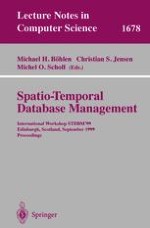1999 | Buch
Spatio-Temporal Database Management
International Workshop STDBM’99 Edinburgh, Scotland, September 10–11, 1999 Proceedings
herausgegeben von: Michael H. Böhlen, Christian S. Jensen, Michel O. Scholl
Verlag: Springer Berlin Heidelberg
Buchreihe : Lecture Notes in Computer Science
Enthalten in: Professional Book Archive
